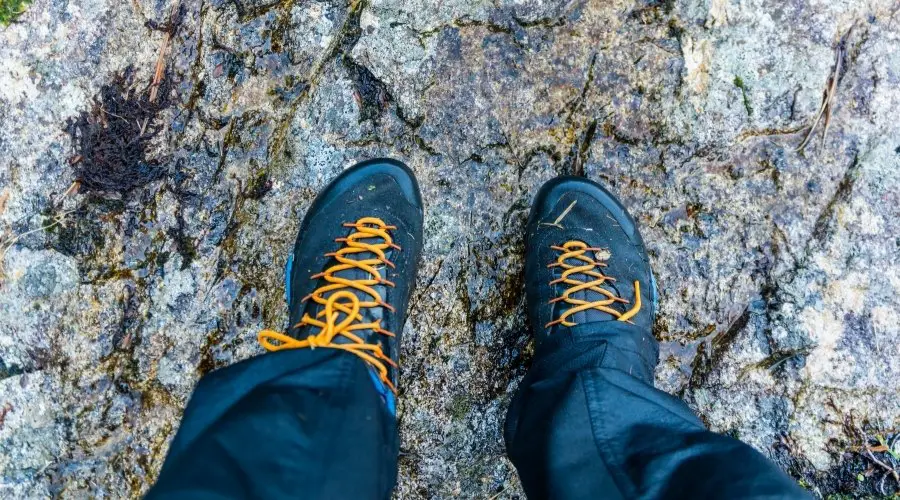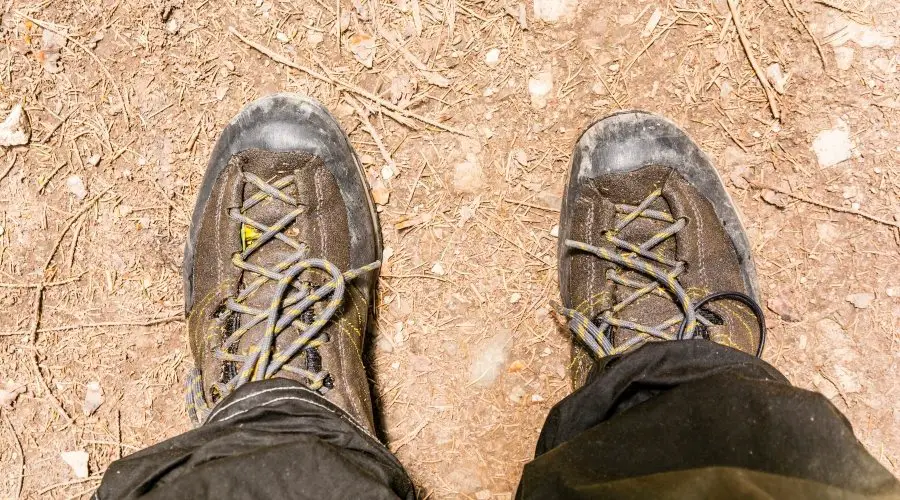Approach shoes have been gaining more traction lately in the climbing community as more climbers are using them. I have heard stories of climbers who claim their approach shoes lasted them less than a month and others who have had a pair of approach shoes for the past 5 years. This got me wondering just how long a pair of approach shoes typically lasts. Here is what I found out.
As a general rule, approach shoes will last approximately 300 to 500 miles before losing a significant amount of performance. This distance range corresponds to approximately 5 to 8 months of moderate use (15 miles per week).
While the amount approach shoes are used play a huge factor in how long they last, it is not the only thing that will determine their lifespan. This article explores the typical lifespan of approach shoes and gives you a few tips on how to extend it.
Expected Lifespan of Approach Shoes

As a general rule of thumb, high quality running shoes last between 300 and 500 miles of use. Trail running shoes are slightly more durable and typically last runners a bit longer.
“Medical journals like the British Journal of Sports Medicine and the Scandinavian Journal of Medicine and Science in Sports say even the best quality of trail shoes will last roughly between 350 and 550 miles.”
When To Replace Trail Running Shoes, runtrails.org
On average, approach shoes are slightly less durable than trail running shoes and will last between 300 and 500 miles before losing a significant amount of integrity. If you are wondering what the main differences are between approach shoes, trail running shoes, and hiking shoes, check out my article here.
That said, not all approach shoes are created equal. Some approach shoes, like the Scarpa Crux II, are designed to be more heavy duty and last longer than others. Keep in mind that this is just a general timeframe for reference. It is impossible to know how long it will take you to travel this distance unless you know approximately how much you will be using them each week.
The table below details how long an average pair of approach shoes will last you based on low, moderate, and high usage rates.
| Usage Rate | Distance per week | Lifespan |
| Low | >10 miles | 14 to 23 months |
| Moderate | 10 to 20 miles | 5 to 8 months |
| High | 20 to 30 miles | 3 to 4.5 months |
You may be wondering if approach shoes are even worth it now that you have an idea of how long they will last you. I wrote an entire article exploring this topic that discusses when exactly approach shoes will be worth it and when they won’t.
When to Replace Approach Shoes

Some climbers choose to continue to use shoes even after they have lost most of their performance. Due to this, determining when to replace approach shoes is really up to the user. That said, there are a few things to look out for that will give you a clue that the approach shoes’ effectiveness is coming to an end.
You should replace your approach shoes when:
- Your feet, ankles, or knees hurt during or after use
- They no longer provide the grip you need
- Their arch support has worn out
- The lugs are no longer present
- The outsole has worn through
- Holes are present in the upper material
While the above signs are good indications that your approach shoes are losing their effectiveness, it is up to you when to replace them. I recommend replacing them sooner rather than later because all it takes is one slip or fall to get seriously injured. Climbing is all about your ability to stay safe and uninjured.
If you are realizing that it is probably about time you replaced your pair or are looking for a new pair, you can check out my personal favorites on Amazon here.
Factors That Affect Approach Shoe Lifespan

There really is not a set timeframe that approach shoes last. It really depends on a lot of factors such as how much they are used, the surface they are worn on, and the shoe’s construction.
Total Amount of Use
What really matters is the total distance you are putting on the shoes. Splitting up 20 miles of hiking into four hikes or doing 20 miles in just one hike won’t affect the lifespan of the shoe dramatically. All that matters is the cumulative 20 miles of hiking.
Obviously if you are wearing them as everyday shoes they will wear out a lot quicker than using them sparingly.
For example – if you are putting 4 miles each day on your approach shoes, they should be replaced within about 3 to 4 months. On the other hand, if you are only using them for a 4 mile hike once per week, they would last you 1.5 to 2.5 years.
The Surface They Are Used On
Using approach shoes on hard abrasive surfaces such as asphalt will eat away at them a lot quicker than walking around on unpaved surfaces such as hiking trails and grassy plains.
It is best to keep this in mind when thinking about wearing them for paved trail hiking. If you will be doing this, try to walk alongside the pavement as much as practical to save your shoe’s stickiness and lifespan.
Different Shoe Construction
As mentioned above, some approach shoes are designed to be more durable than others.
In general, shoes with stiffer outsoles will be more durable and last longer than softer ones. Softer outsoles will provide climbers with better sensitivity and traction but will typically be thinner and easier to wear down. Shoes with a soft outsole are even more susceptible to increased wear on asphalt and other abrasive surfaces.
The more durable approach shoes will typically be better for crags with long hikes in while the less durable ones will be better for crags that require a decent amount of scrambling up boulder fields to reach them.
Tips to Make Approach Shoes Last Longer

The following are different ways to make sure your approach shoes last you a long time.
Do Not Wear Them For Everyday Use
If you are looking to get the most out of your approach shoes, wearing them as your everyday shoes is not ideal. Not only will you be putting a tremendous amount of miles on them, you will likely be subjecting them to a lot of walking on asphalt and concrete surfaces.
Use Them In Conjunction With Trail Runners or Hiking Shoes
Instead of using your approach shoes for the entire hike into the crag/route, split it up with trail runners or hiking shoes. Trail runners and hiking shoes are generally more durable and supportive than approach shoes. That said, they will not handle any scrambling nearly as well.
Saving your approach shoes for the scrambling portion of the hike in will keep their mileage way down and save them for their most important job. It doesn’t matter how cool the crag is if you twist an ankle getting there and can’t climb.
Store Them Properly
Storing your approach shoes out in a cool, dry place out of the sunlight will help keep them in good condition. UV rays and high temperatures are harmful to the shoes and can damage the glue holding them together. Leaving them in the trunk of your car during the summer is not ideal for their longevity.
Keeping them dry is just a good hygiene practice that will prevent mold from developing. If your shoes get really sweaty, I recommend deodorizing them or washing them.
